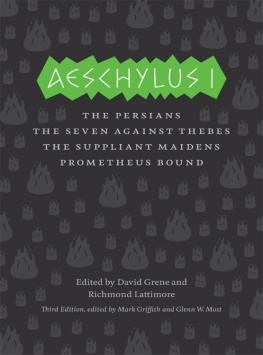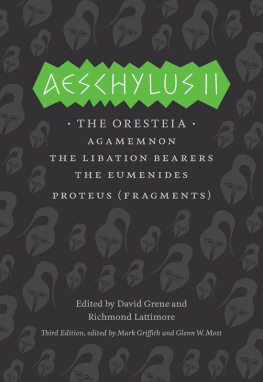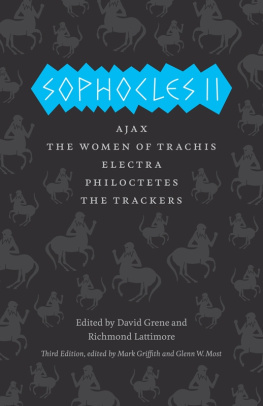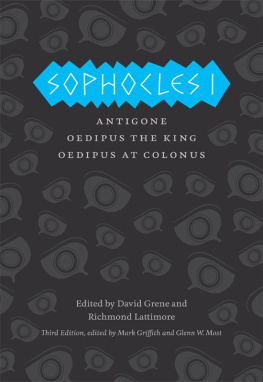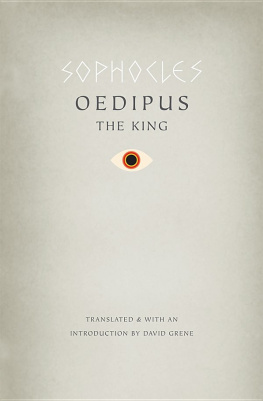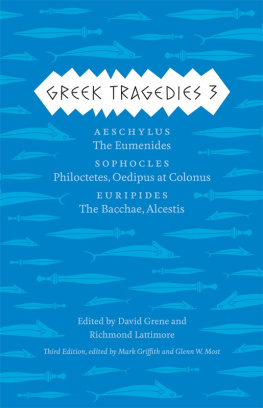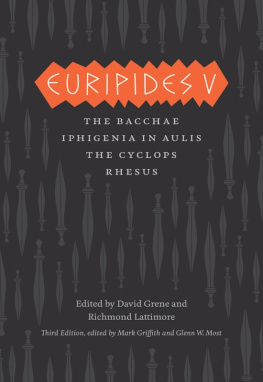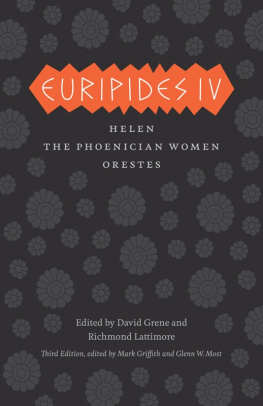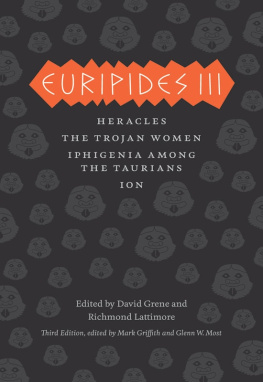Translated by SETH BENARDETE
THE PERSIANS: INTRODUCTION
The Play: Date and Composition
Aeschylus Persians is the earliest surviving Greek tragedy. It was first performed in 472 BCE, as part of a tetralogy made up of plays on quite different themes. We know the titles of the other three plays, though the plays themselves have been lost except for fragments: Phineus, Glaucus of Potniae, and the satyr-drama Prometheus Fire-Kindler. All three were on mythological subjects, and it appears they had little in common. So in this particular year Aeschylus followed the pattern that was more usual with other tragedians, including Sophocles and Euripides, of composing four quite separate plays as his entry into the competition, rather than a tightly connected tetralogy like the Oresteia. The production won first prize.
We are informed by ancient sources that the play was performed at least once in Sicily, a year or two after its first performance in Athens, at the request of the ruler of Syracuse, Hieron. We do not know whether Aeschylus rewrote the play for this performance or adapted it to take into account the Sicilians victory over Eastern invaders (the Carthaginians), which occurred on almost the same date as the Athenian victory over the Persians at Salamis; and, if so, which version we possess today.
The Story
The idea of basing a tragic drama on a recent historical event, rather than on traditional myth, may seem surprising to modern readers; but it was apparently not so unusual in the early decades of tragic competition in Athens. In fact Aeschylus celebrated predecessor and rival, Phrynichus, had previously produced a tragedy, The Phoenician Women, on exactly this same theme; and an ancient scholar quotes the first line of Phrynichus play to demonstrate that Aeschylus whole play was heavily dependent on it.
The momentous events of 480479 BCE were of course well known to all Greeks; and the Athenians had played a central role in them. King Xerxes of Persia had led an enormous invading force of troops and ships into Greece. Athens had been evacuated and occupied by the invading forces, but in an amazing reversal, Athenian ships had crushingly defeated the Persian navy and thereby ruined the Persian strategy of a combined land and sea operation to take over the rest of the mainland. Xerxes himself had watched the crucial sea battle off the island of Salamis, just a few miles from the city of Athens. Afterward, a considerable contingent of the Persian forces, including Xerxes, returned home, leaving a large army to continue the campaign on land. The next spring (479) this army was in turn resoundingly defeated by Greek forces led by the Spartans, at the battle of Plataea. Thus the Persians had for a second time in a decade been repelled (the first time had been Darius much smaller assault, defeated by Athenian infantry at Marathon in 490), and the independence of Athens and other Greek city states had been preserved.
These events immediately acquired a status in the Greek national consciousness comparable to the capture of Troy, or the exploits of Theseus and Heracleseminently suitable material for tragic drama. At the same time, it would hardly be appropriate for a living Greek man to be made the central focus of a tragedy: instead, Aeschylus followed the example of Phrynichus and set his play in the Persian court, with the main focus on the royal family. Nonetheless, this tragedy concentrating on the disastrous turnaround of the Persian kings fortunes was obviously at the same time a celebration of Athenian success in particular and of Greek discipline and values in general.
The action of Aeschylus play takes place in front of the tomb of King Darius at the palace in Sousa, Persias capital city. The chorus of Persian elders (a body of senior advisers to the royal family) begins by anxiously discussing the status of the expedition that left to invade Greece several months earlier, led by King Xerxes himself. Then the queen (not named in the play, though we know from Herodotus and from Persian documents that this is Atossa, widow of Darius and mother of Xerxes) arrives to talk with them, and tells them of an ominous dream she has had. A messenger arrives, announcing the catastrophic defeat at Salamis and narrating in detail the loss of Persian lives and ships, including the painful and costly march of retreat through northern Greece. The queen and chorus are devastated, but also relieved to learn that Xerxes is safe and returning home, though his clothing is in shreds (from mourning) and his spirit broken. The chorus, at the queens suggestion, now conjures up the dead spirit of King Darius, Xerxes father, from his tomb. Darius expresses disapproval and disappointment at his sons failure, and goes on to predict the impending defeat at Plataea. After Darius ghost returns to the underworld, and the queen also departs to prepare to greet her son, Xerxes himself arrives, and the final scene consists of a long lyric lament, sung in antiphonal exchange between the chorus and their king.
Aeschylus play is the earliest extant account of the events of the Persian Wars: the much more extensive and detailed narrative of Herodotus in his Histories was not composed until some forty years later. But the play was never intended to accurately represent historical reality. Although it has plenty of oriental coloring (costumes, exotic wailing and dancing, self-abasement of the chorus in the presence of royalty), for the most part the Persians speak like Greeks and observe largely Greek customs and religion. The resounding lists of foreign names are colorful but not very authentic. The scale of the massacre of Persian troops on land that is described as the culmination of the slaughter at Salamis (lines 44171) seems to be greatly exaggerated. The references to Darius unblemished military record are somewhat fanciful, and Xerxes entry on foot in the final scene, with torn clothing and minimal retinue, suggests a degree of catastrophe and humiliation far removed from the actual Persian experience. Instead of historical authenticity, Aeschylus sought and achieved brilliant dramatic impact, especially through such striking effects as the queens dream, the apparition of the ghost of old king Darius, the pathos of Persian loss and bewilderment, and the elaborate incantations and lamentations of the chorus.
After Aeschylus Persians, we do not hear of any further stagings of tragedies depicting recent historical events in the fifth-century Athenian theater. Certainly neither Sophocles nor Euripides ever wrote such a play. We do not know why this change of fashion occurred. By contrast, in the Roman theater, historical dramas constituted a flourishing genre, with Octavia (attributed, wrongly, to Seneca) a sole surviving example.
Transmission and Reception
Beyond the plays reperformance in Sicily, The Persians continued to be well known in Athens throughout the fifth century, and Herodotus must have known the play, though he makes little obvious use of Aeschylus particular themes or language. At the end of the century, the exotic flavor of Aeschylus music and choreography in the play is mentioned approvingly in Aristophanes Frogs, and the innovative musician and poet Timotheus drew extensively from it in his own Persians (of which a substantial fragment survives on papyrus). In the Hellenistic period, the Jewish playwright Ezekiel likewise adapted episodes from Aeschylus play for his Exodus (Exagog). But for the most part, it was Herodotus account of Xerxes invasion and the Persian royal court that was best known and most influential for later writers and composers.
In general, Aeschylus plays were much less widely read in ancient schools or for pleasure than the plays of Sophocles or (especially) Euripides. Most of them gradually ceased to be copied and faded into oblivion. When the time came to make a selected edition of seven Aeschylean plays (at some point in the Roman period, perhaps for school use),

